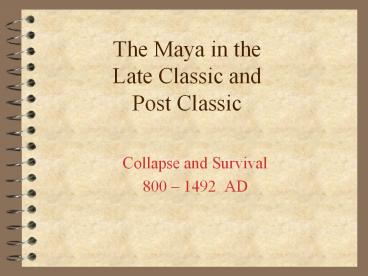The Maya in the Late Classic and Post Classic - PowerPoint PPT Presentation
1 / 27
Title:
The Maya in the Late Classic and Post Classic
Description:
The Maya in the Late Classic and Post Classic Collapse and Survival 800 1492 AD Collapse The fall of Mayan cities from great centers of commerce and ritual with ... – PowerPoint PPT presentation
Number of Views:153
Avg rating:3.0/5.0
Title: The Maya in the Late Classic and Post Classic
1
The Maya in the Late Classic and Post Classic
- Collapse and Survival
- 800 1492 AD
2
(No Transcript)
3
Collapse
- The fall of Mayan cities from great centers of
commerce and ritual with large populations to
complete abandonment around 900 AD has mystified
people for a long time. - However, the entire Mayan civilization did not
collapse.
4
- Collapse of cities primarily occurred in the
southern lowlands and highlands of Guatemala.
Other regions of the Mayan culture continue to
thrive. - Today the principal hypothesis for decline is
focused on environmental factors.
5
Environmental Stress
- The combined affects of prolonged drought, crop
failures, internal war, overpopulation and civil
unrest are seen as the likely cause of
disintegration of Mayan culture in the southern
regions and Guatemala. - The period is marked by extensive population
movements north and west.
6
- Palynological studies (pollen analysis) from
cores in lakes and other sediment sources
indicate a drought period of 100 years and
limited crop production. - Oxygen isotope studies confirm abrupt climate
changes - Gylphs indicate increased inter-city conflict and
a dynamic change in the type of war, from
ritualized to resource based and total.
7
Oxygen isotope studies reveal period of drought
that coincides with Mayan decline.
8
Patterns
- Mayan civilization was never an empire.
Independent city-states shared culture, but not
centralized, singular political authority. - Teotihuacan had risen to power and remained
strong for four centuries, only to collapse for
many of the same reasons as the Maya.
9
- Chichen, Uxmal and other cities of the northern
lowlands, extending to Yucatan, expanded and
thrived in the centuries following the
collapse. - By 900 the Itza culture moved into Chichen and
Puuc culture extended into southern Yucatan.
10
- Toward late post-classic these remaining centers
fell under the political and cultural influence
of Toltec and later Aztec cultures.
11
Rise of Tula (legendary Tollan)
- Toltec poorly understood (most sites disturbed)
- 900-1150 AD
- Origins in West Mexico
- Aztec legends associate Toltec with militarism.
- Urban population reaching at least 60,000 at the
capital. - Large rectangular plaza layout, grid of similar
orientation to Teotihuacan.
12
(No Transcript)
13
- Too high in elevation to successfully cultivate
cacao or cotton. - Layout similar to Teotihuacan in miniature.
- Like Teotihuacán tula had Pyramids of moon and
sun.
- Similarities to Chichen- itza temple of warriors
with colonnade. - Representation of Quetzalcoatl as Venus god .
Kukulcan. - Introduce Coantpantli to architecture.
14
Chocmool of Toltec style.
15
Quetzalcoatl like this were featured on Tula
temples.
16
Tula. Temple with Atlantian figures. Small scale
talud tablero style.
17
(No Transcript)
18
Tula pyramid. Hidalgo.
19
Digital reconstruction of Tula by Antonio
Serrato-Combe
Completely destroyed by 1156 AD.
20
Site plan of Chichen itza Temple of the
Warriors. Here the Toltec influence is strong in
during late Post-classic.
21
View from Temple of Warriors toward horizon. El
Castillo visible.
22
Notes on the Toltec
- Militaristic.
- Art exhibits formal, rigid style.
- Master craftsmen and artisans.
- Long distance trade networks maintained by
military alliances. Sea traders. - Early metal workers--crafting objects in bronze.
- Much admired by the Aztec.
23
Neighboring regions
- Michoacan, Toluca, Morelos
- Chollua, Valley of Puebla
- Tribute states within these sectors provided
raw goods and luxury items - Alliances through marriage and trade.
- Trade may have reached north further than ever.
(Some suspect it reached American Southwest).
24
Religious traditions
- Gods included Kukulcan, as a version of
Quetzalcoatl (Mayan) - Rival god Tezcatlipoca (god of night and north)
25
Most significant changes
- Innovation of the spindle whorl
- Molcajete (tripod grinding bowl) similar to
Teotihuacán style. - Expansionism northward through conquest.
- By 1300 the Toltec had splintered into small
groups and abandoned most northern sites.
26
- Mayan cities continue until arrival of the
Spanish but with very different institutions and
customs resulting from thee centuries of
Toltec/Aztec influence. - Final stronghold falls to conquistadores in 1530.
27
- Demise of major centers has overshadowed the
reality that many Mayan centers continued in
other regions and prospered. - Mayan people are not a lost civilization, but
represent a civilization in decline and under
foreign rule. - 7,500,000 Maya alive today in Mexico and Guatemala































